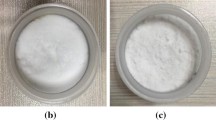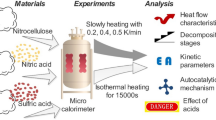Abstract
In order to prevent the spontaneous ignition of nitrocellulose (NC), NC is stabilized by washing with industrial water in its synthesis process. However, there is a possibility that the components in industrial water contribute to the thermal stability of NC. In this way, the purpose of this study is to clarify the effect of industrial water components on the thermal stability of NC. In experiments, a heat flux calorimeter was used to observe the thermal behavior of NC with the residue of vaporized industrial water. The induction period of heat release of NC with 2-mass% residues was approximately 2–5 h shorter than that of NC alone whose induction period was observed at 7 h. Those results indicate that the residue destabilized NC. On the other hand, when the additive amount of the residue was increased, the induction period gradually increased as well. Based upon these results, we assume that inorganic salts contributing to stabilization and destabilization competitively coexist in the industrial water components. The same thermal analysis was performed on NC with CaCO3, CaSO4, CaCl, ZnSO4, NaCl, and CuCl. Those salts are predicted to exist in the industrial water. In the results, the induction period of NC with 2-mass% CaCO3 was approximately 15-h longer than that of NC alone, while the induction period with the inorganic salts CaSO4, CaCl, ZnSO4, NaCl, and CuCl was 4–5-h shorter. Therefore, when the industrial water components accumulate in NC, the destabilization by inorganic salts such as CaSO4, CaCl, ZnSO4, NaCl, and CuCl and the stabilization by compounds such as CaCO3 are thought to countervail against each other.







Similar content being viewed by others
References
Relational Information System for Chemical Accidents Database (RISCAD) http://riodb.ibase.aist.go.jp/riscad/index.php, Accident ID: 84.
Katoh K, Ito S, Abe S, Owa Heisig K, Kubota S, Ogata Y, Wada Y. An analysis of the explosion accidents during the storage of nitrocellulose which occurred in Japan. In: The 3rd international symposium on energetic materials and their applications, 2008.
Editorial Department Japan Explosives Society. Ippan kayakugaku. Japan Explosives Society; 1998. p. 172–173 (in Japanese).
Osada H. Kayaku chemistry. Maruzen: Maruzen Corp., Ltd; 2003. p. 190–2. (in Japanese).
Katoh K, Le L, Kumasaki M, Wada Y, Arai M, Tamura M. Study on the spontaneous ignition mechanism of nitric esters (I). Thermochim Acta. 2005;431:161.
Katoh K, Le L, Itoh M, Arai M, Tamura M. Study on the spontaneous ignition of cellulose nitrate and the effect of the type of the storage atmosphere (II). Sci Technol Energ Mater. 2004;65:77.
Kimura J, Arisawa H, Hayashi H. New finding of hydroperoxides in nitrate esters as decomposition intermediates, Technical report of technical research and development, Ministry of Defense, 1994, 6531.
Kimura J. Chemiluminescence study on thermal decomposition of nitrate esters. Propellants Explos Pyrotech. 1989;14:89.
Kawaguchi S, Kubota K, Nakatsuka K. A study of stability improvement of nitrocellulose by water washing. In: Proceedings of the annual conference of the Japan Explosives Society; 2002. p. 73–76. (in Japanese).
URL of Bureau of Waterworks, Tokyo metropolitan government, http://www.waterworks.metro.tokyo.jp/water/w_info/s_kijun2.html.
MSDS of CaCO3, Wako Pure Chemical Corp.
MSDS of CaNO2, Wako Pure Chemical Corp.
Author information
Authors and Affiliations
Corresponding author
Rights and permissions
About this article
Cite this article
Katoh, K., Ito, S., Ogata, Y. et al. Effect of industrial water components on thermal stability of nitrocellulose. J Therm Anal Calorim 99, 159–164 (2010). https://doi.org/10.1007/s10973-009-0492-7
Published:
Issue Date:
DOI: https://doi.org/10.1007/s10973-009-0492-7




